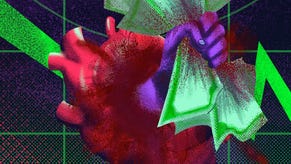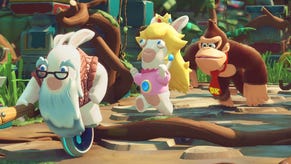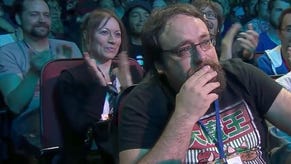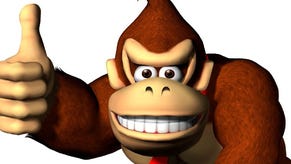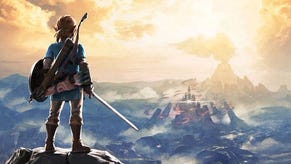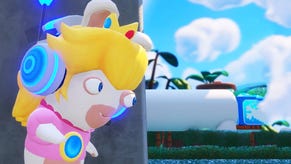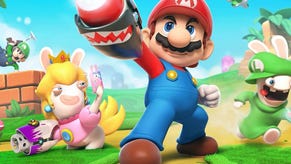The pitch that convinced Miyamoto to back Mario Rabbids
Here's A Thing.
Davide Soliani isn't just your typical Nintendo fan. 15 years ago, upon finding out that legendary Nintendo designer Shigeru Miyamoto - the man that had made him want to create video games in the first place - was going to be visiting Italy to promote a new Zelda game, he decided he had to meet him in person.
So determined was he and a group of friends that they rang hotels throughout the city Miyamoto was visiting, claiming to be his Italian translators, until finally they found out where he was staying. They raced over to the hotel and proceeded to wait, for hours, in the cold and rain. It didn't matter one bit that Soliani was suffering from a fever at the time, that wasn't going to stop him from meeting his idol and expressing his gratitude.
For Miyamoto this may have been a quick photo and a few autographs, but for Soliani, it was an incredibly important moment. Even then he dreamt of someday working alongside this man, who in his eyes was quite simply the greatest game developer in the world.

That very same year, in fact, Soliani started work on a Game Boy Advance demo for Wind Waker, in the hopes that Nintendo might want to outsource a handheld version of the game. The idea was eventually shut down by his bosses at Ubisoft, but Soliani's desire to work on a core Nintendo franchise remained. And eventually, more than a decade later, he'd get his shot.
Having been promoted to Creative Director at Ubisoft Milan, Soliani was tasked with brainstorming a new game that could revitalise the Rabbids brand. The party games were no longer selling like they used to and so it'd need to be something new. If the idea was strong enough, he was told, there might even be an opportunity to collaborate with Nintendo.
That's all Soliani needed to hear. He eagerly started putting together a team.
And that's where he encountered his first problem. Ubisoft Milan at this point in time was going all out on Ghost Recon: Wildlands and could barely spare any additional resources. This meant Soliani was left with just a handful of designers, a tiny workspace and not a single programmer with which to start work on his dream game.
"We were alone without a coder," explained Soliani. "So even before having one, we tried to see by ourselves, if we could manage to prototype a paper design that could help us. I still have the dice we were using to move our action figures behind cover and the rulers we used for line-of-sight."
The team would then invite other people from the studio into their tiny room to play it for themselves, with Soliani and the other designers acting as the game's dungeon masters.

It was through this process that the early design started to take shape. Players weren't too crazy about the game having a wide range of different hit percentages when firing a weapon and so they were simplified. On top of this, there was a feeling that the combat was too similar to other turn-based strategy games like XCOM. It needed something else. And so the game's inventive movement system with its dashes and team jumps was fleshed out.
After a few weeks of testing it was becoming increasingly apparent that the team needed at least someone on board that could actually write code.
"Luckily, we found a very junior coder," said Soliani. "He had basically no experience because he was coding for a company that was requiring him to display 3D pieces of motorbikes. It was a guy working for MV Agusta, an Italian motor company. This work was completely new for him and he arrived at a very busy moment."
That very same week, Ubisoft's management gave the team the go ahead. In fact, they'd been so impressed by the paper prototype they'd even gone ahead and set up a meeting between Soliani and Shigeru Miyamoto in just three and a half weeks time.
Despite having a single programmer, and an inexperienced one at that, the team decided they had to create a fully playable demo. If they were going to convince the man that made Mario that they could be trusted with his work, there was no room for half measures.
Putting the rest of their lives on hold, the group created a short multiplayer demo that pitted two players against one another as they controlled Mario, Luigi and a variety of Rabbids.
The artists spent much of their time recreating Mario and Luigi in particular. They compared their work with previous Nintendo games in real-time, checked animation frame-by-frame on YouTube and searched frantically for any design documentation they could find online.
I've seen the demo for myself, although I can't share any footage unfortunately, but I will say: the level of detail, particularly when it came to character design, was remarkable.
The meeting itself was a short one, as Soliani presented the demo, half-shaking as he sat next to Miyamoto.
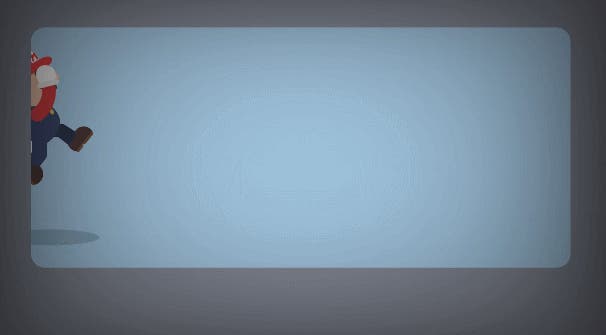
"I was already super scared," said Soliani. "Because I was presenting this game to the designer that defined my childhood."
Nintendo, it turned out, hadn't expected a playable demo. Nor had they really envisioned Mario holding a gun, but something else surprised them too.
"How did you recreate Mario and Luigi like this?" asked Miyamoto.
"We did them ourselves," responded Soliani. "Just for this meeting."
Miyamoto took a moment to look at this nervous Italian man sitting next to him. "I'm impressed," he concluded. "Let's meet again in a few months time. You should come to Kyoto."
Soliani returned to his team in Milan and broke the good news: Nintendo seem to like what we're doing, he told them. And then the bad news: that means we're going to need a new prototype. A much bigger, better prototype than the last one. And we've got about three months to get it done.
Ubisoft, encouraged by this news, shifted a few more developers over to the Rabbids project, although even at its height, there were only around 14 people working on this second prototype and some of those were having to split their attention between this work and Ghost Recon.
"That was crazy," said Soliani. "Because we worked even harder and I almost believed I had a heart attack. I went to the hospital. asking them to check my heart. Everything was fine, but I told them I'd been working Saturday and Sunday until 2AM and they told me: you're a moron and I needed to chill out. After I knew that I had no problem, I went back to work."
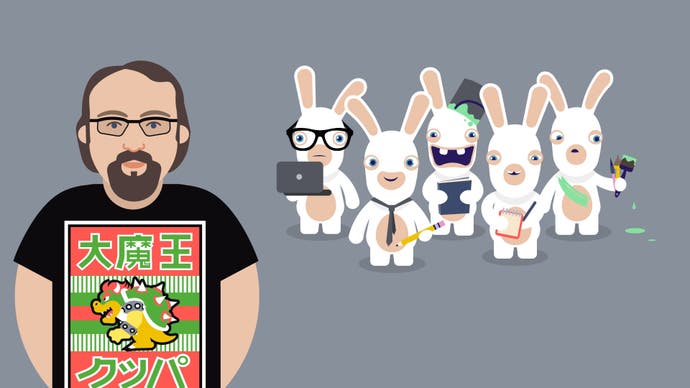
The team created what was essentially a full level of the game called Luigi Rescue, mixing exploration and combat over several stages before ending with a boss fight. Alongside this, there were a series of dojo levels used to demonstrate each of the game's mechanics, from taking cover, to team jumping to the combat itself. You've got to remember, there's never been a turn-based tactical Mario game before. Once again, this small group of developers was desperate to exceed expectations.
Soliani flew to Kyoto to give the most important presentation of his career and this time it's not just in front of Miyamoto either, there's a whole boardroom full of Nintendo Japan's top brass to impress. To make matters worse, he was exhausted. The previous night while unable to sleep, Soliani and his producer had gone to pay homage to the original Nintendo headquarters instead.
This is the man that pretended to be Miyamoto's translator in order to get a photograph after all.
The presentation took up most of the day, as Soliani gave his final, impassioned pitch for Mario + Rabbids: Kingdom Battle. The only break arriving in the form of lunch, which incredibly, is signalled by the Mario theme playing throughout the building. They then play the Zelda theme to let everyone know when it's over. Seriously.
After seven hours of presenting due to the amount of gameplay and required translation, Soliani thanks everyone for listening and awaits their verdict. Everything had led to this moment.
The room then remained silent for something like two full minutes. That may not sound like a lot, but for an exuberant Italian man like Davide Soliani, it must have been torture.
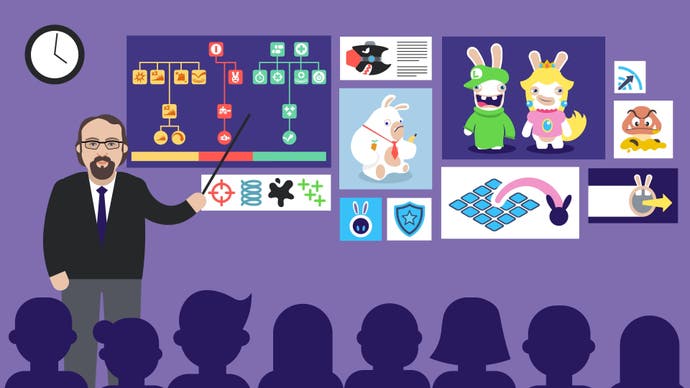
Noticing his discomfort, Miyamoto told him not to worry and explained that the group was simply taking its time to think and collect any thoughts before speaking.
Finally, they put him out his misery. The game looks great, they said. Like Captain Toad, but even more over-the-top. And more than anything else, Soliani and his team had done something here that Nintendo themselves could not. Not only was this a genre Mario hadn't been involved with before, but also the interactions between him and the Rabbids offered something fresh: a different type of humour that benefited from the inclusion of both franchises.
It wouldn't have been enough to make a good Mario game. Nintendo already have some experience there, I think it's fair to say. The secret to Soliani's success was bringing something different for them to consider. Well that, and a lifelong passion for everything Shigeru Miyamoto has ever been involved with. That might have played a part too.
"Davide was so incredibly passionate when explaining the idea," explained Miyamoto in a developer diary for the game. "I fell in love with his passion, and that was the moment I realized this project could work."
In fact, what this story has made me think about more than anything else is the E3 2017 reveal for Mario Rabbids. Yes, I'm talking about the one where Davide Soliani is seen in the crowd in tears, spawning the hashtag #DontCryUbisoftMan.
Most people didn't know who he was back then, hence the name Ubisoft Man, which feels a tad heartless on our behalf now that we know this story, doesn't it? Of course he was crying. What a journey that team had gone through to get to this moment. Cry as much as you like Davide, you deserve it.
Illustration & anni-mation by: Anni Sayers.



